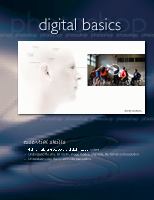

38
essential skills: photoshop CS3
9LZHTWSPUN N\PKLSPULZ!
When resampling keep in mind the following guidelines for ensuring the best results:
Images captured with the correct number of pixels for the required print job will always
1.
produce better results than those that have been interpolated.
The softening effect that results from high levels of interpolation is less noticeable in general,
2.
landscape or portrait images and more apparent in images with sharp-edged elements.
The more detail and pixels in the original file the better the interpolated results will be.
3.
A well-exposed, sharply focused original file that is saved in a lossless format such as TIFF is
4.
the best candidate image for upsizing.
>OH[ PZ PU[LYWVSH[PVU HU`^H`&
Interpolation is a process by which extra pixels are generated in a low-resolution image
so that it can be printed at a larger size than its original dimensions would normally
allow. Interpolation, or as it is sometimes called, upsizing, can be implemented via
software products such as the Image Size > Resample option in Photoshop or by using
the resize options in the printer’s hardware.
Both approaches work by sampling a group of pixels (a 4 × 4 matrix in the case of
bicubic interpolation) and using this information together with a special algorithm as a
basis for generating the values for newly created pixels that will be added to the image.
The sophistication of the algorithm and the size of the sampling set determine the
quality of the interpolated results.
7YPU[LY IHZLK YLZHTWSPUN
An alternative approach to using Photoshop to resample your picture is to make use of the
‘scaling’ options in your printer driver dialog. Most desktop and high-end laboratory digital
printers are capable of the interpolation necessary to produce big prints.
When outsourcing to a professional printer the file is kept to its original pixel dimensions and the
resolution is reduced so that the print size
will equal the required print dimensions. The
digital printer is then instructed to interpolate
the file as it was printing to its optimum
resolution of the machine. On the desktop
a similar process is used with the digital
photographer selecting a scale value, or an
option to match the image size to the paper
dimensions, in the print or print driver dialog.
Letting the output device perform the
interpolation of the image has the following
advantages: the process does not require the
photographer to change the original file in
any way and it removes an extra processing
step from the file preparation process.
















